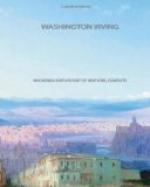The most probable account declares, that what with the constant troubles on his frontiers—the incessant schemings and projects going on in his own pericranium—the memorials, petitions, remonstrances, and sage pieces of advice of respectable meetings of the sovereign people, and the refractory disposition of his councillors, who were sure to differ from him on every point, and uniformly to be in the wrong—his mind was kept in a furnace heat, until he became as completely burnt out as a Dutch family pipe which has passed through three generations of hard smokers. In this manner did he undergo a kind of animal combustion consuming away like a farthing rushlight, so that when grim Death finally snuffed him out, there was scarcely left enough of him to bury!
FOOTNOTES:
[37] “The old Welsh bards
believed that King Arthur was not dead,
but
carried awaie by the fairies into some pleasant place,
where
he
sholde remaine for a time, and then returne againe
and reigne
in
as great authority as ever.”—Holinshed.
“The Britons suppose that he shall come yet and conquere all Britaigne; for, certes, this is the prophicye of Merlyn—He say’d that his deth shall be doubteous; and said soth, for men thereof yet have doubte and shullen for evermore, for men wyt not whether that he lyveth or is dede.”—De Leew Chron.
[38] Diedrich Knickerbocker, in
his scrupulous search after
truth,
is sometimes too fastidious in regard to facts which
border
a little on the marvelous. The story of the golden
ore
rests
on something better than mere tradition. The venerable
Adrian
Van der Donck, Doctor of Laws, in his description of
the
New
Netherlands, asserts it from his own observation as
an
eye-witness.
He was present, he says, in 1645, at a treaty
between
Governor Kieft and the Mohawk Indians, in which one
of
the
latter, in painting himself for the ceremony, used
a pigment,
the
weight and shining appearance of which excited the
curiosity
of
the governor and Mynheer Van der Donck. They obtained
a lump
and
gave it to be proved by a skillful doctor of medicine,
Johannes
de la Montagne, one of the councillors of the New
Netherlands.
It was put into a crucible, and yielded two pieces
of
gold worth about three guilders. All this, continues
Adrian
Van
der Donck, was kept secret. As soon as peace was
made with
the
Mohawks, an officer and a few men were sent to the
mountain,
in
the region of the Kaatskill, under the guidance of
an Indian,
to
search for the precious mineral. They brought
back a bucketful
of
ore, which, being submitted to the crucible, proved
as
productive
as the first. William Kieft now thought the discovery




